Eduard 1/48 Sopwith Camels – Billy Barker
To my mind, the Eduard 1/48 Camel is the best kit of this important airplane available. I haven't seen it available in recent years, but those who are interested in obtaining a kit might drop me a line because I have a local hobby shop that actually keeps things around, and doesn't raise prices just because it's become "collectible," and the last time I looked there were three of these kits there, including the very rare 2.F1 "Sea Camel."
First up is Billy Barker's Sopwith Camel. Surprisingly William George "Billy" Barker (1894-1930), who remains Canada's most highly decorated soldier and served as a highly successful fighter pilot during the First World War, is not among the best-known pilots of that conflict despite his standing as the most-successful fighter pilot with the Sopwith Camel, and his ranking as Number One Canadian Ace of all time (after assessing the liar Billy Bishop in light of the evidence), ahead of Raymond Collishaw. This may be due to the fact that the majority of his combat service as a fighter pilot occurred on the Italian Front in 1917-18, rather than on the Western Front with its greater publicity. Barker arrived in France as a machine-gunner in June 1915, with the First Canadian Mounted Rifles.Four days after his arrival, he was in the middle of the Second Battle of Ypres. One day, he sat back and watched in amazement as a Fokker Eindecker shot down an British two-seater reconnaissance plane; like many other aces, he decided the best way out of the trenches was to join the Royal Flying Corps. The RFC was in short supply of observers, and they were accepting men from the front with minimal qualifications. However, he was rejected on his first application. Unfazed, Barker, reapplied and was accepted at his rank of Corporal. After six days of training that consisted of map reading, aerial photography and communication techniques for artillery spotting (since he was a machine gunner already he skipped that part), he was given his Observer's badge and posted to No. 9 Squadron at Bertangles, France, flying the outdated B.E.2c over a very active portion of the Western Front. After several months in 9 Squadron, he was promoted to 2nd Lt. and officially attached to the Royal Flying Corps in April, 1916. Posted to No. 4 Squadron as an observer, Barker's aerial combat career began with the Battle of the Somme, which commenced on July 1, 1916. The B.E.2c's of 4 Squadron were in the thick of the fighting, performing aerial photography and artillery spotting. Over the course of the first weeks of the offensive, almost all of the original crews were killed or POWs, except for Barker, who participated in some very dangerous missions spotting enemy troop concentrations from low level and directing artillery fire to their positions. In mid-July he was transferred to No. 15 Squadron, which supported the Canadian Corps. He even managed to kill a German pilot in late July when a Halberstadt scout dove out of the sun onto six B.E.'s, anticipating an easy kill. Despite his location in the front seat, having to fire over the head of his pilot, Barker shot down the German. Two weeks later, he downed a second scout in flames and was Mentioned in Despatches.
During the Battle of Cambrai in September 1916, Barker and his pilot showed great quality and determination during a mission to photograph new German defensive works. Over the German lines, they were attacked by a pair of Albatros D.IIs. Most BE2c pilots would have turned tail and headed for home, but not Barker's pilot. They fought off the two German scouts, doing so much damage to one that both fled. After completing their photo mission, they were intercepted by four more Albatroses. Again, they fought with such skill that they drove them off, returning successfully to their home field to deliver the photos. This mission brought Barker his first decoration of the Military Cross. On November 18, 1916, Barker's application for pilot training was accepted and he was sent to Narborough, England. A natural pilot, he soloed after an incredibly short 55 minutes of dual instruction in January 1917.
Barker was posted back to No. 15 Squadron, which was now equipped with the R.E.8. In February he was promoted to Captain. Barker shot down an enemy plane in March and rapidly became known as the best recon pilot on the front. In April, during the Battle of Arras, he earned another Mentioned In Despatches for directing shell fire onto a trench filled with 1,000 German troops. A few days later, in a low-altitude mission, he directed shell fire directly onto two troublesome long-range artillery guns. His airplane was badly damaged, but he made it back to be awarded a second Military Cross and was promoted to C Flight Commander.
Barker was sent back to England to become an instructor in September, 1917. It was here that he got his first taste of flying in a Sopwith Camel. The fast, temperamental new fighter was a revelation, and he renewed his efforts to be assigned to a fighter squadron. After an extremely low pass over the HQ buildings, he was posted to 28 Squadron, which flew Camels. His first combat mission as a fighter pilot was on October 20, 1917 as part of an air-cover element for a bombing mission to Rumbeke Aerodrome in support of Camels and French SPADs carrying bombs. It was during this time that he made the acquaintance of Camel B6313, which would become his mount for a year of air combat in which he would become the most-successful Camel pilot, and B6313 would become the most-successful individual Sopwith Camel of the war.
In late October, Barker became an ace by downing two Albatros D.IIIs. Leading a flight of six Camels, they spotted German troops in a rainstorm and went down to strafe them. Moments after their first run, they were surprised by a flight of Albatroses. Two of the Camels immediately spun in under fire and Barker was flying for his life. Turning as tight as possible, he barely cleared a copse of trees, then suddenly pulled up into a loop. He pulled out of the loop less than ten feet above the ground behind his opponent and put a burst into the pilot which sent the plane crashing into the ground. When another D.III got on his tail, Barker repeated the loop and shot down his sixth aircraft. Two days later, he downed his seventh German fighter.
At about the same time that Barker was making ace, the Italian Army was losing the Battle of Caporetto, a defeat which nearly took Italy out of the war. To demonstrate support for their ally, the Royal Flying Corps decided to send four fighter squadrons and one reconnaissance squadron to Italy. Among those was 28 Squadron. One British pilot wrote of the war in Italy: "Flying in Italy was a holiday by comparison with that in France. It was a different type of warfare entirely. It was more of a gentleman's war. The scout pilots we encountered in Italy didn't seem to have the same viciousness that we met up with on the Western Front where it was a blood for blood affair. They were not so aggressive in Italy." Nevertheless, while the units might have been smaller, a man could meet death in the air as easily over the Venetian plain as over the fields of Flanders.
Shortly after arrival in Italy in late November, 1917, Barker opening the aerial score for the RFC over Senaglia-Pieve di Soligo when his flight of four Camels was jumped by 12 Austrian Albatros D.IIIs. After 20 minutes of dogfighting, Barker ended the skirmish by downing one of their opponents. Barker described the battle as follows in his combat log: "I dived on one and fired about 50 rounds and he went down in a vertical dive. I followed and as he flattened out at 5,000 feet I got a burst of about 80 rounds at close range. His top wing folded back to the fuselage and then the lower wing came off." On Christmas Day, 1917 Barker, Lt. William Hudson and another pilot decided to send seasons greetings to the Austrians at nearby Motta Aerodrome. They wrote "To the Austrian Flying Corps from the English RFC, wishing you a Merry X-Mas" on a large piece of cardboard, then proceeded to fly across the field wingtip-to-wingtip strafing everything in sight. The trio made it back to their base at Istrana and quietly convinced the mechanics to patch the bullet holes, as unauthorized flying had been banned by the British commander, Lt. Col. Phillip Joubert.
On Jan 5, 1918 Barker was awarded the Distinguished Service Order, Britain's second highest award for valor. His colleague, Captain Mitchell described Barker thus: "Whilst one could not say he was a good pilot, he certainly made up for this in his shooting. I was his deputy leader and probably knew more about him than anyone else. I have seen enemy machines break up in the air or go down in flames under his fire long before I realized they were in range." When not flying Barker was not exactly a model fighter pilot, and probably not a lot of fun to be around. He didn't drink or smoke, didn't carouse with the others, nor participate in the mess hall parties and pranks. He was more likely to be found on the aircraft line doing maintenance on his aircraft, cleaning the guns or talking to the mechanics and armorers. He lived to fly and fight. His only "pranks" were played on the Austrians.
On January 24, 1918, Barker opened his balloon-busting score with Lt. Hudson flying wing. Balloons were considered so dangerous that Joubert had ordered his pilots to refrain from attacking them. Allegedly out to test their machine guns and engines, Barker and Hudson spotted two balloons near Conegliano on the Piave River. Barker destroyed both balloons while Hudson strafed the anti-aircraft machine gun positions. On return to base, Barker could only offer the excuse to Joubert that, once he saw the balloons, he forgot all about the order. On Feb. 12, Barker and Hudson again went out to "test their guns." Barker observed that the thick ground mist below provided ideal conditions for attacking balloons. Two large balloons near Fossamerlo were destroyed, along with three smaller ones. During the attack, Barker shot down a defending Albatros D.III, and then swooped down on an Austrian staff car and strafed it into a ditch where it flipped over and exploded. Barker and Hudson became a team, flying together whenever possible, each protecting the other during attacks, thereby heralding the tactic of two planes flying as "fluid" leader and wingman, alternating when the situation demands it, which is the modern method of air combat.
On April 10, 1918, Barker was made a Flight Commander in 66 Squadron. On April 17, he shot down an Albatros D.III, and in May he downed 8 Austrian aircraft. In June, Barker was awarded his second bar to the Military Cross for work done in the first two months of 1918; this was his third award of the Military Cross.
On May 25, 1918, Barker met up with one of Austria's most famous aces, Frank Linke-Crawford. Barker was leading an offensive patrol of Bristol Fighters in his Camel when they met an Austrian formation of 10 machines. Barker immediately attacked and noticed Linke-Crawford's Albatros with its distinctive black and white checkerboard markings. He singled out the Austrian and dove after him, entering into a dogfight. Short bursts of machine-gun fire occasionally broke the air, but neither ace was hit. Barker found Linke-Crawford a superb flyer, but a mediocre shot. Even with the Camel's agility, Barker could not hold Linke-Crawford in his sights long enough for a killing burst. Rather than continue a game that his opponent was obviously good at, and not willing to let him go, Barker circled off to about 200 yards, and came at Linke-Crawford from head on. He began firing as soon as he lined up, and could see his tracers hitting the Albatros. Linke-Crawford dove sharply and headed home, but Barker whipped the Camel about and dove after him. Just before the Austrian reached ground level, Barker caught up to him and put his tracers through the gas tank. Linke-Crawford crashed in flames and died just short of his own airfield.
Even a famous ace like Barker did not escape unscathed. During the summer of 1918, during the final Austrian offensive, he was shot down twice. In the first, he landed in Lake Garda and had to be rescued with a rowboat, while the second time he made a forced landing in the foothills. His Camel hit hard, the undercarriage tore off and it did a flip, landing on its back. He had the airplane pulled off the hillside and rebuilt.
On July 18th, Barker in his Camel and one of his Bristol Fighters, with some others from 66 Squadron shot down an entire flight of five Austrians. Barker shot down an L.V.G. two-seater in flames, the others downed three, and British AA gunners scored on the fifth aircraft. On July 20, Barker and two Bristols intercepted a flight of Austrian aircraft attacking Motta Airfield. Barker downed two Albatross DIIIs and a Bristol downed a third. By now Barker had 33 enemy aircraft and 9 balloons to his credit, and was awarded a bar to his Distinguished Service Order. In late August, 1918, Barker took the Prince of Wales on two combat missions over the front in a Bristol Fighter. In September, Barker was ordered back to England to take command of the fighter school at Hounslow. At this time, B6313 was disassembled and packed up for shipment back to England.
The kit was modfied per photos of B6313, with additional openings in the cowling. I used an Aeromaster sheet that had marking for the airplane in August 1918 when Barker commanded 139 Squadron. I used Blue Max "Yew" wood decal for the interplane struts, and Aeromaster "dark wood" for the prop. I used Aeromaster "Light Wood" decal for the fuselage sides and the turtleback area of the cockpit, "varnished" with Tamiya Clear Yellow.

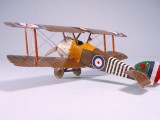
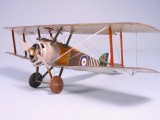
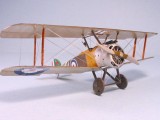

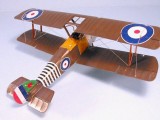
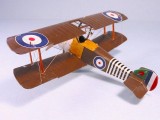
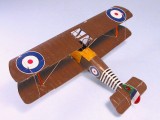
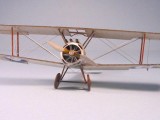
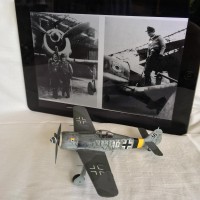
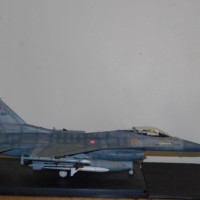

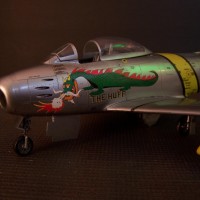
This article alone will charm anyone interested in WWI aircraft to go out and buy and build one of these Eduard kits. I know I did...buy one . I'm still working on the building part. Having written that confession, the photo's and the articles in this Camel series are informative, well written and tie in with the hobby with a ease that most models can only dream about writing. Two Thumbs up on promoting tobacco free Camels.